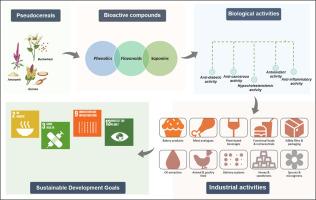Pseudocereals for modern diets: Multifunctional grains with superior bioactive properties, nutraceutical potential, and diverse industrial applications
引用次数: 0
Abstract
Pseudocereals, such as quinoa, buckwheat, and amaranth, have emerged as promising alternatives to traditional cereals due to their superior nutritional composition, abundance of bioactive compounds, and multifunctional properties. This review synthesizes the current knowledge of bioactive compounds present in these multifunctional grains, highlighting their superior antioxidant, anti-inflammatory, anticancer, hypocholesterolemic, and antidiabetic properties. It discusses the major bioactive compounds, including polyphenols, flavonoids, saponins, fagopyritols, and peptides, and advanced analytical approaches, including HPLC and UPLC for separation, and MS/MS and NMR spectroscopy for detection and structural elucidation. The review also highlights the nutraceutical potential of pseudocereals in preventing chronic diseases, promoting overall health, and addressing nutritional deficiencies. Furthermore, pseudocereals demonstrate significant industrial potential through their versatile applications in gluten-free bakery products, meat analogues, dairy substitutes, fermented beverages, edible films, animal feed formulations, and nutraceutical delivery systems. Considering their adaptability to marginal environments, resilience to climate stress, and superior nutritional profiles, integrating pseudocereals into modern agriculture and diets aligns with achieving SDGs such as zero hunger, good health and well-being, and sustainable agriculture. This review serves as a comprehensive resource bridging the gap between research and industry applications, highlighting future opportunities for utilizing pseudocereals to enhance food security and support sustainable agricultural systems.

现代饮食中的伪谷物:具有优越生物活性特性、营养保健潜力和多种工业应用的多功能谷物
假谷物,如藜麦、荞麦和苋菜,由于其优越的营养成分、丰富的生物活性化合物和多功能特性,已成为传统谷物的有希望的替代品。本文综述了这些多功能谷物中存在的生物活性化合物的最新知识,重点介绍了它们优越的抗氧化、抗炎、抗癌、降胆固醇和抗糖尿病的特性。它讨论了主要的生物活性成分,包括多酚、类黄酮、皂苷、金荞麦醇和多肽,以及先进的分析方法,包括HPLC和UPLC的分离,以及MS/MS和NMR的检测和结构解析。该综述还强调了假谷物在预防慢性疾病、促进整体健康和解决营养缺乏方面的营养潜力。此外,假谷物通过其在无麸质烘焙产品、肉类类似物、乳制品替代品、发酵饮料、食用薄膜、动物饲料配方和营养保健输送系统中的广泛应用,显示出巨大的工业潜力。考虑到假谷物对边缘环境的适应性、对气候压力的抵御能力和优越的营养状况,将假谷物纳入现代农业和饮食符合实现零饥饿、良好健康和福祉以及可持续农业等可持续发展目标。本综述为弥合研究与工业应用之间的差距提供了综合性资源,强调了利用假谷物加强粮食安全和支持可持续农业系统的未来机遇。
本文章由计算机程序翻译,如有差异,请以英文原文为准。
求助全文
约1分钟内获得全文
求助全文
来源期刊

Food chemistry advances
Analytical Chemistry, Organic Chemistry, Chemistry (General), Molecular Biology
CiteScore
1.90
自引率
0.00%
发文量
0
审稿时长
99 days
 求助内容:
求助内容: 应助结果提醒方式:
应助结果提醒方式:


